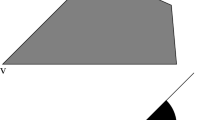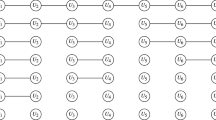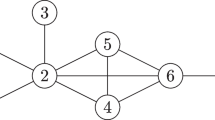Abstract
We study the number of copies of a weakly connected subdigraph of the k nearest neighbor (kNN) digraph based on data from certain random point processes in \(\mathbb {R}^d\). In particular, based on the asymptotic theory for functionals of point sets from homogeneous Poisson process (HPP) and uniform binomial process (UBP), we provide a general result for the asymptotic behavior of the number of weakly connected subdigraphs of kNN digraphs. As corollaries, we obtain asymptotic results for the number of vertices with fixed indegree, the number of shared kNN pairs, and the number of reflexive kNNs in the kNN digraph based on data from HPP and UBP. We also provide several extensions of our results pertaining to the kNN digraphs; more specifically, the results are extended to the number of weakly connected subdigraphs in a digraph based only on a subset of the first k NNs, and in a marked or labeled digraph where each vertex also has a mark or a label associated with it, and also to the number of subgraphs of the underlying kNN graphs. These constructs derived from kNN digraphs, kNN graphs, and the marked/labeled kNN graphs have applications in various fields such as pattern classification and spatial data analysis, and our extensions provide the theoretical basis for certain tools in these areas.





Similar content being viewed by others
References
Avram, F., Bertsimas, D.: On central limit theorems in geometrical probability. Ann. Appl. Probab. 3(4), 1033–1046 (1993)
Bahadır, S., Ceyhan, E.: On the number of reflexive and shared nearest neighbor pairs in one-dimensional uniform data. Probab. Math. Stat. 38(1), 123–137 (2018)
Bickel, P.J., Breiman, L.: Sums of functions of nearest neighbor distances, moment bounds, limit theorems and a goodness of fit test. Ann. Probab. 11(1), 185–214 (1983)
Brito, M.R., Quiroz, A.J., Yukich, J.E.: Intrinsic dimension identification via graph-theoretic methods. J. Multivariate Anal. 116, 263–277 (2013)
Ceyhan, E.: Overall and pairwise segregation tests based on nearest neighbor contingency tables. Comput. Stat. Data Anal. 53(8), 2786–2808 (2009)
Ceyhan, E.: Testing spatial symmetry using contingency tables based on nearest neighbor relations. Sci. World J. 2014, # 698296 (2014)
Ceyhan, E., Bahadır, S.: Nearest neighbor methods for testing reflexivity. Environ. Ecol. Stat. 24(1), 69–108 (2017)
Chartrand, G., Lesniak, L.: Graphs & Digraphs. Chapman & Hall, London (1996)
Clark, P.J., Evans, F.C.: On some aspects of spatial pattern in biological populations. Science 121(3142), 397–398 (1955)
Conway, J.H., Sloane, N.J.A.: Sphere Packings, Lattices and Groups. Grundlehren der Mathematischen Wissenschaften, vol. 290. Springer, New York (1988)
Cox, T.F.: Reflexive nearest neighbors. Biometrics 37(2), 367–369 (1981)
Cuzick, J., Edwards, R.: Spatial clustering for inhomogeneous populations. With discussion and a reply by the authors. J. R. Stat. Soc. Ser. B 52(1), 73–104 (1990)
Dacey, M.F.: The spacing of river towns. Ann. Assoc. Am. Geogr. 50(1), 59–61 (1960)
Dixon, P.: Testing spatial segregation using a nearest-neighbor contingency table. Ecology 75(7), 1940–1948 (1994)
Dixon, P.M.: Nearest-neighbor contingency table analysis of spatial segregation for several species. Écoscience 9(2), 142–151 (2002)
Enns, E.G., Ehlers, P.F., Misi, T.: A cluster problem as defined by nearest neighbours. Can. J. Stat. 27(4), 843–851 (1999)
Eppstein, D., Paterson, M.S., Yao, F.F.: On nearest-neighbor graphs. Discrete Comput. Geom. 17(3), 263–282 (1997)
Erdős, P., Rényi, A.: On the evolution of random graphs. Magyar Tud. Akad. Mat. Kutató Int. Közl. 5, 17–61 (1960)
Friedman, J.H., Rafsky, L.C.: Graph-theoretic measures of multivariate association and prediction. Ann. Stat. 11(2), 377–391 (1983)
Henze, N.: On the fraction of random points with specified nearest-neighbour interrelations and degree of attraction. Adv. Appl. Probab. 19(4), 873–895 (1987)
Janson, S., Oleszkiewicz, K., Ruciński, A.: Upper tails for subgraph counts in random graphs. Isr. J. Math. 142, 61–92 (2004)
Kabatiansky, G.A., Levenshtein, V.I.: On bounds for packings on a sphere and in space. Probl. Peredachi Inf. 14(1), 3–25 (1978). (in Russian)
Lachièze-Rey, R., Schulte, M., Yukich, J.E.: Normal approximation for stabilizing functionals. Ann. Appl. Probab. 29(2), 931–993 (2019)
Musin, O.R.: The kissing number in four dimensions. Ann. Math. 168(1), 1–32 (2008)
Najim, Ch.A., Russo, R.P.: On the number of subgraphs of a specified form embedded in a random graph. Methodol. Comput. Appl. Probab. 5(1), 23–33 (2003)
Newman, C.M., Rinott, Y., Tversky, A.: Nearest neighbors and Voronoi regions in certain point processes. Adv. Appl. Probab. 15(4), 726–751 (1983)
Nowicki, K., Wierman, J.C.: Subgraph counts in random graphs using incomplete \(U\)-statistics methods. Discrete Math. 72(1–3), 299–310 (1988)
Penrose, M.: Random Geometric Graphs. Oxford Studies in Probability, vol. 5. Oxford University Press, Oxford (2003)
Penrose, M.D.: Gaussian limits for random geometric measures. Electron. J. Probab. 12, 989–1035 (2007)
Penrose, M.D., Yukich, J.E.: Central limit theorems for some graphs in computational geometry. Ann. Appl. Probab. 11(4), 1005–1041 (2001)
Penrose, M.D., Yukich, J.E.: Limit theory for random sequential packing and deposition. Ann. Appl. Probab. 12(1), 272–301 (2002)
Penrose, M.D., Yukich, J.E.: Normal approximation in geometric probability. In: Stein’s Method and Applications. Lecture Notes Series, Institute for Mathematical Sciences, vol. 5, pp. 37–58. Singapore University Press, Singapore (2005)
Pickard, D.K.: Isolated nearest neighbors. J. Appl. Probab. 19(2), 444–449 (1982)
Roberts, F.D.K.: Nearest neighbours in a Poisson ensemble. Biometrika 56(2), 401–406 (1969)
Ruciński, A.: When are small subgraphs of a random graph normally distributed? Probab. Theory Relat. Fields 78(1), 1–10 (1988)
Schilling, M.F.: Mutual and shared neighbor probabilities: finite- and infinite-dimensional results. Adv. Appl. Probab. 18(2), 388–405 (1986)
Shang, Y.: Laws of large numbers of subgraphs in directed random geometric networks. Int. Electron. J. Pure Appl. Math. 2(2), 69–79 (2010)
Trinh, K.D.: On central limit theorems in stochastic geometry for add-one cost stabilizing functionals. Electron. Commun. Probab. 24, # 76 (2019)
Wade, A.R.: Explicit laws of large numbers for random nearest-neighbour-type graphs. Adv. Appl. Probab. 39(2), 326–342 (2007)
Wyner, A.D.: Capabilities of bounded discrepancy decoding. Bell System Tech. J. 44, 1061–1122 (1965)
Yao, Y.-C., Simons, G.: A large-dimensional independent and identically distributed property for nearest neighbor counts in Poisson processes. Ann. Appl. Probab. 6(2), 561–571 (1996)
Yu, C.W.: Computing subgraph probability of random geometric graphs with applications in quantitative analysis of ad hoc networks. IEEE J. Select. Areas Commun. 27(7), 1056–1065 (2009)
Author information
Authors and Affiliations
Corresponding author
Additional information
Editor in Charge: Kenneth Clarkson
Publisher's Note
Springer Nature remains neutral with regard to jurisdictional claims in published maps and institutional affiliations.
Rights and permissions
About this article
Cite this article
Bahadır, S., Ceyhan, E. On the Number of Weakly Connected Subdigraphs in Random kNN Digraphs. Discrete Comput Geom 65, 116–142 (2021). https://doi.org/10.1007/s00454-020-00218-8
Received:
Revised:
Accepted:
Published:
Issue Date:
DOI: https://doi.org/10.1007/s00454-020-00218-8




